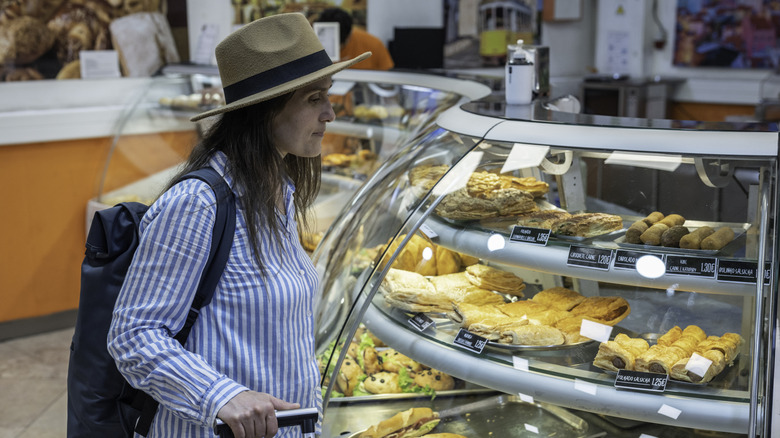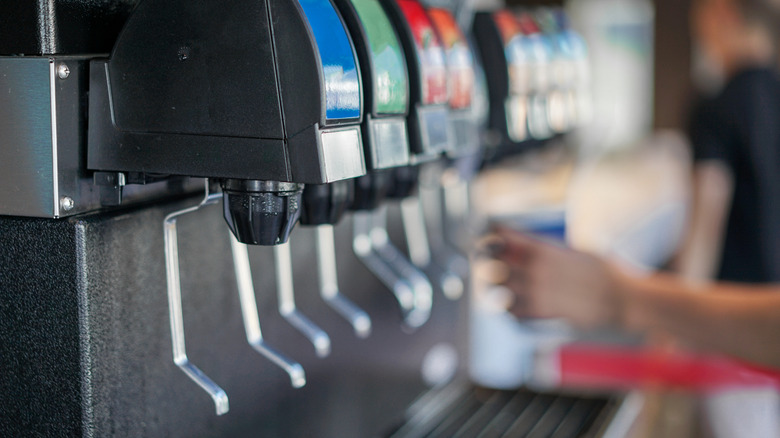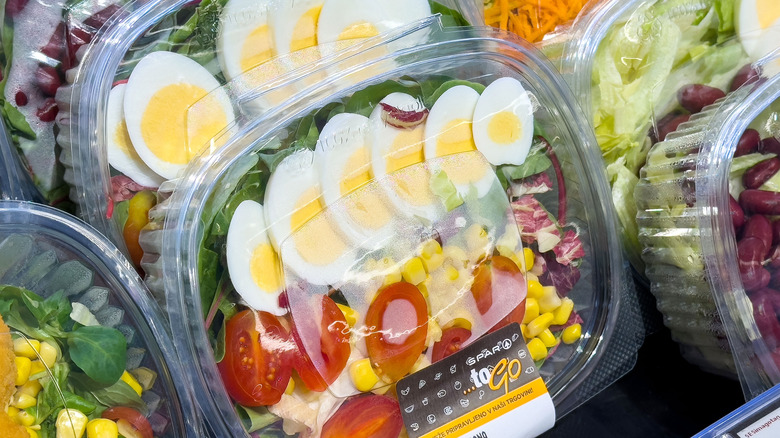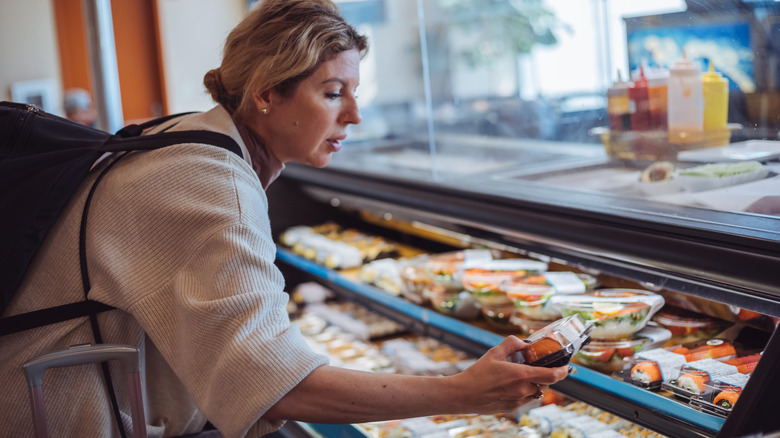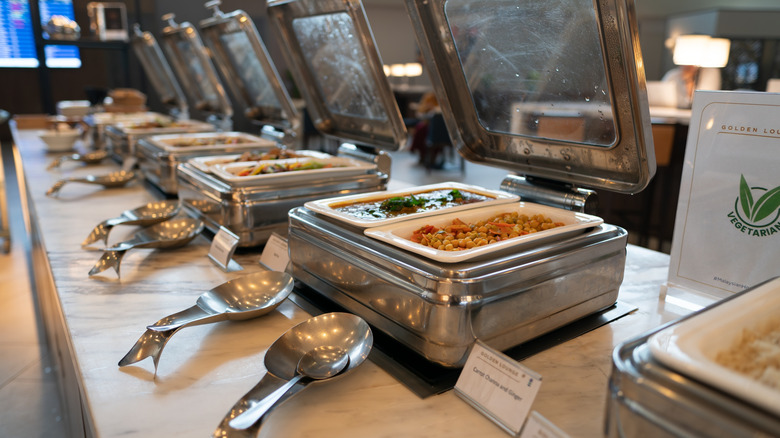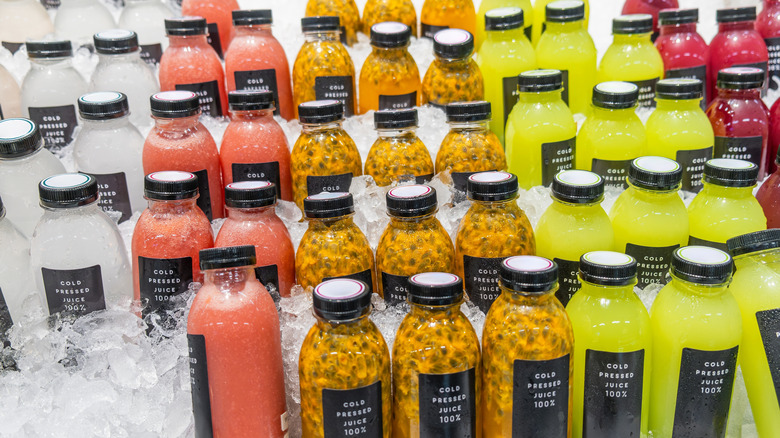The Types Of Airport Food Every Traveler Should Avoid (And Why)
Are you the type of traveler who'll do anything to avoid airplane food? You're not alone. Many flyers stay away from in-flight meals, either because of questionable hygiene concerns or because they find that the food simply tastes different on planes. That leaves many passengers opting for pre-flight meals or snacks at the airport to fill in the long dwell times before flights. "Dining is perhaps the single activity that unites almost all travelers — our 2024 passenger research found that only 2% say they never eat or drink at the airport, and 64% prioritize dining as part of their airport experience," said Errol McGlothan, president of airport hospitality company Airport Dimensions.
Although the airport food and beverage landscape has evolved to accommodate a smorgasbord of culinary choices for both picky eaters and enthusiastic foodies, there are still certain types of food that travelers should avoid before boarding their plane. Considering the limited kitchen space, quick food turnovers, and an airport's operational constraints, food safety raises legitimate concerns for air passengers, especially before taking a long flight. Here are some examples of foods that can be risky to consume at airports, according to experts.
Say no to soda fountain drinks
Fast-food chains offer frazzled travelers quick and comforting meals during airport downtime, but maybe think twice before sipping the soda fountain drink that comes with those set menus. As a consumer, you can't verify the cleanliness of a drink coming from a soda fountain, a machine that requires meticulous and thorough cleaning to begin with. A 2023 study on bulk dispenser contamination by the International Water Association Publishing revealed that 41% of soda fountains showed the presence of total coliforms, which include E.coli.
Although the New York Department of Health acknowledges that contaminated drinking water supplies such as soda fountains rarely cause sickness, positive coliform bacteria tests may indicate that more harmful bacteria are lurking in the shadows. If you're craving a soda, pick up a canned or bottled drink instead. Or better yet, pass on any fizzy drinks before and during a flight — aside from dehydrating you, carbonated drinks can bring on motion sickness, headaches, or bloating — symptoms you could definitely do without while traveling.
Skip the prepackaged salads and sandwiches
Think you're eating healthy by grabbing those pre-packaged sandwiches, fruit cups, or salads from the grab-and-go airport kiosk shelves? Think again. It's hard to judge just how long these items have been sitting on the shelves, and whether they've been kept at optimal conditions to ensure their freshness at all. Open refrigeration units for these kinds of ready-made airport foods may not be cold enough to stop bacteria from growing.
Bagged salads can be breeding grounds for E. coli, Salmonella, and Listeria — and can produce even more infection-causing germs due to the presence of salad leaf juices, University of Leicester microbiologist Primrose Freestone confided to The Conversation. The same goes for sliced fruit, where peeled and exposed portions make fruit cups particularly susceptible to bacteria. If you must insist on having that airport salad or sandwich, don't store it away to eat at a later time: Freestone suggests eating it as soon as possible. When left at room temperature for more than four hours, cut tomatoes and leafy vegetables can breed bacteria quite rapidly.
Don't eat the sushi or oysters
Maybe wait until you're at Japan's Food Town, Tokyo's giant market with traditional Japanese eats, before indulging in sushi. Airport sushi — or any raw food in general — can quickly become dangerous if prepared under improper or unsanitary storage and handling conditions, as Gastro Health gastroenterologist Ali A. Khan told The Washington Post when asked about the safety of airport sushi. Given his knowledge of airport restaurant kitchens' behind-the-scenes operations, James Beard Award-winning chef Tim Carman agreed, stating that airport restaurants are usually operated by third-party concessionaires, making it harder to vet their safety and health standards.
The Centers for Disease Control and Prevention considers sushi among the riskier choices in the seafood category, alongside raw shellfish, sashimi, and ceviche. Without ideal and sanitary conditions and preparations, sushi can result in food poisoning, diarrhea, nausea, and vomiting, sometimes within hours of ingestion. Stay away from those fancy raw oyster bars in London's Heathrow Airport or Paris's Charles de Gaulle Airport — raw oysters can cause cramping, nausea, fever, and chills from Vibrio bacteria infections. If you must have seafood, opt for cooked varieties like grilled salmon or tempura.
Avoid airport buffets
For most passengers, relaxing in any of the best airport lounges in the world is an airport layover win — not only do they offer comfortable chairs and drinks on tap, but an airport buffet as well. Sadly, the quality of food at these self-serve stations is highly questionable. Who knows how long they've been sitting out under those heat lamps, which may or may not be warm enough to actually keep the food at the correct temperatures? Plus, the uncovered containers of buffet food are prone to contamination from a myriad of factors: lines of people shuffling past the buffet, germs from people talking or coughing over or near the food, or even flies or insects that unknowingly land on food. Without constant surveillance, serving spoons also tend to get misplaced in the buffet line shuffle. As a result, utensils used for different dishes can cause cross-contamination, transferring bacteria from one platter to another.
Maintaining food at proper temperatures is another important airport buffet health risk. "Harmful bacteria multiply rapidly in what experts call the 'danger zone': the temperature range between 8 degrees Celsius (46 degrees Fahrenheit) and 64 degrees Celsius (147 degrees Fahrenheit)," microbiologist and associate professor Kimon-Andreas Karatzas shares with The Conversation. "If food sits within this range for too long, it becomes an ideal breeding ground for microbes." Buffet spreads are prone to a buffet of bacteria as well, ranging from Salmonella found in raw or undercooked eggs and dairy; Listeria in soft cheeses, unheated deli meat, or melon left out for more than two hours; to Clostridium that affects stews or roasts that are heated for extended periods, to name a few.
Don't drink unpasteurized juices or smoothies
We're often under the impression that freshly squeezed, cold-pressed juices or smoothies are the smarter alternative to sodas. But the U.S. Food and Drug Administration warns that unpasteurized juices, which are commonly found at airport kiosk fridges, can be more of a health risk if safety standards haven't been met. Since they haven't undergone the heating process that rids fresh produce of harmful bacteria, consuming unpasteurized drinks like fruit and vegetable juices or cider can lead to food poisoning, vomiting, diarrhea, or abdominal pain. Plus, not knowing how long they've been sitting in airport refrigerators or whether they've been maintained at proper temperatures makes them quite a gamble, especially before boarding a plane.
Similar to the cleanliness concerns surrounding soda fountains, improperly cleaned juicers, blenders, or other equipment used to prepare unpasteurized juices or smoothies also leave you vulnerable to bacterial contamination. To stay on the safe side, check the labels on fruit or vegetable juices before purchasing — the FDA requires all unpasteurized drinks to carry a label, with the exception of those sold by the glass. Stick to pasteurized drinks or bottled water instead.
